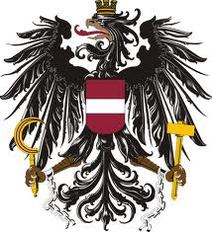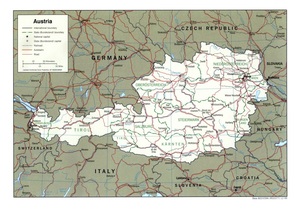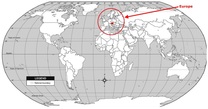Physical Geography
Austria is split up into nine provinces, each with a very unique culture as so many different countries surround them. The provinces are: Vorarlberg, Tirol, Salzburg, Upper Austria, Carinthia, Styria, Burgenland, Lower Austria, and Vienna. Each is influenced by different cultures as Austria shares borders with nine different countries. The countries are: Germany, CzechRepublic, Slovakia, Hungary, Slovenia, Italy, Switzerland and Liechtenstein.
Austria is famous for it’s Alps, which occupy 62% of the country. The Alps further diversify Austria as before, they were believed to be impassable, and so communication was minimal. The highest point of the Alps is Grossglocker, and is 12, 457 feet above sea level. Despite the harsh conditions, people have settled in areas around the Alps and due to the isolation, have developed there own dialects, clothing, folklore and even architecture.
The DanubeRiver is the only navigable water in Austria and is an important part of not only the geography, but also settlement and resources. The DanubeRiver flows from South East Germany across Northern Austria. (Griffin)
Austria is famous for it’s Alps, which occupy 62% of the country. The Alps further diversify Austria as before, they were believed to be impassable, and so communication was minimal. The highest point of the Alps is Grossglocker, and is 12, 457 feet above sea level. Despite the harsh conditions, people have settled in areas around the Alps and due to the isolation, have developed there own dialects, clothing, folklore and even architecture.
The DanubeRiver is the only navigable water in Austria and is an important part of not only the geography, but also settlement and resources. The DanubeRiver flows from South East Germany across Northern Austria. (Griffin)
Language
The principle language of Austria is German, with about 98% of the country speaking it. The dialect in which the Austrians speak in has been described as softer than the German that Germans speak. Other languages spoken include Turkish, Serbian, and Croatian, which is the official language in the province of Burgenland. (Griffin)
Culture

The national emblem of Austria is a Black eagle of the Austrian coast of arms. The crown on the eagle represents the middle class of Austrians, the sickle in the left talon represents farmers, and the hammer in the right represents the artisans. The broken silver chains symbolize freedom from Nazi German control and the red and white on the flag and eagle represent the blood-stained tunic worn by Duke Leopold the fifth of Babenberg after the battle of Ptolemais. The Leontopodium Alpinum is one of the most famous Alpine plants, which grow in Austria, and has even become a sort of national plant. (Griffin)
Culture is Austria include Austrians, which make up 91.1% of Austria, former Yugoslavs (including Croatians, Slovenes, Serbs, and Bosniaks) making up 4%, Turks make 1.6%, Germans make 0.9%, and others make up a total of 2.4%. (Griffin)
Culture is Austria include Austrians, which make up 91.1% of Austria, former Yugoslavs (including Croatians, Slovenes, Serbs, and Bosniaks) making up 4%, Turks make 1.6%, Germans make 0.9%, and others make up a total of 2.4%. (Griffin)
Food
Austrian food is a mix of German, Hungarian, Czech and Northern Italian influence. Austrians start off with a light breakfast, normally coffee with bread and jam, or sausages with mustard on a hard roll as a morning snack. Lunch is the main time for eating, starting with soup, then on to the main course of meats, including sausages, and their famous Wiener Schnitzel, accompanied by potatoes or noodles, and ends with a salad. It is common for Austrians living in the city to take midmorning coffee breaks at coffee houses, which are a source for breakfast, snack, or a light lunch. Austrian farmers support 90% of the country with the average harvest. (Griffin)
Social
Traditionally, Austria was highly stratified and had a very well defined social order. During the 1800’s, the three main groups of people were citizens, peasant farmers, and peasant serfs. (CIA, 2010) Social levels are less apparent now, and most of the population is either middle of high class. Foreign workers and immigrants are still less accepted than citizens of Austria though.
Government
The Parties of the federal Republic are Alliance for the Future of Austria or BZOe [Josef BUCHER] and Austrian People's Party or OeVP [Josef PROELL]. National day has been set up on the 26th of October to celebrate Austria’s passage of neutrality. (CIA, 2010)
Economy
Austria has a very well developed market and a high standard of living. The GDP per capita for Austria is 39, 200 as of 2009. Although Austria and Germany have grown apart, Austria still holds strong tie with Germany and have benefited greatly in the past from strong commercial relations, in banking and insurance sectors. In the Agriculture industry, the main crops and livestock are: grains, potatoes, sugar beets, wine, fruit; dairy products, cattle, pigs, poultry and lumber. Other industries include: construction, machinery, vehicles and parts, food, metals, chemicals, lumber and wood processing, paper and paperboard, communications equipment and tourism. (CIA, 2010)
Military

The German name for the Austria army is Österreichisches Bundesheer, meaning Austrian Armed Force in English. (Wikipedia) Branches of the Austrian army include the land force, air command, mission support, international missions, command support, and special forces command (Wikipedia). Since Austria is landlocked, it has no official navy. (Wikipedia) Unlike Canada, military service is compulsory for those of the age 18 to 35 in Austria. The compulsory service time is 6 months and then after, and then an 8 year reserve obligation. (CIA, 2010) Since Austria has declared everlasting neutrality, the Austrian Army's main purpose is to maintain and protect Austria's neutrality. (Wikipedia) The dress of the military is gray, but on special occasions white (Wikipedia). The berets indicate the branch in which each soldier is in: scarlet for artillery; green for infantry; black for armory; cherry for air force; and dark blue for quartermaster. (Wikipedia)


